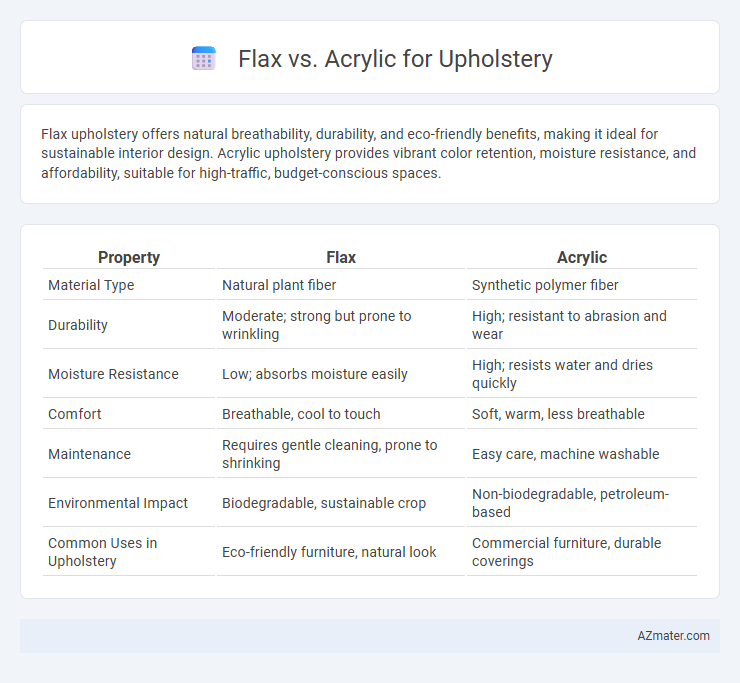Flax upholstery offers natural breathability, durability, and eco-friendly benefits, making it ideal for sustainable interior design. Acrylic upholstery provides vibrant color retention, moisture resistance, and affordability, suitable for high-traffic, budget-conscious spaces.
Table of Comparison
| Property | Flax | Acrylic |
|---|---|---|
| Material Type | Natural plant fiber | Synthetic polymer fiber |
| Durability | Moderate; strong but prone to wrinkling | High; resistant to abrasion and wear |
| Moisture Resistance | Low; absorbs moisture easily | High; resists water and dries quickly |
| Comfort | Breathable, cool to touch | Soft, warm, less breathable |
| Maintenance | Requires gentle cleaning, prone to shrinking | Easy care, machine washable |
| Environmental Impact | Biodegradable, sustainable crop | Non-biodegradable, petroleum-based |
| Common Uses in Upholstery | Eco-friendly furniture, natural look | Commercial furniture, durable coverings |
Introduction: Flax vs Acrylic Upholstery Fabrics
Flax upholstery fabric, derived from natural flax fibers, offers exceptional durability, breathability, and a soft, textured feel ideal for sustainable furniture. Acrylic upholstery provides vibrant color retention, resistance to fading, and affordability, making it popular for versatile and budget-conscious designs. Comparing flax and acrylic highlights the trade-offs between eco-friendly natural fibers and the practicality of synthetic performance.
Key Characteristics of Flax Upholstery
Flax upholstery offers exceptional durability and breathability due to its natural fiber composition, making it ideal for high-traffic areas prone to moisture. The fabric features a distinctive texture with a subtle luster that enhances the tactile appeal and visual depth of furniture. Its hypoallergenic and eco-friendly properties contribute to a healthier indoor environment, aligning with sustainable interior design practices.
Core Features of Acrylic Upholstery
Acrylic upholstery offers exceptional durability, stain resistance, and colorfastness, making it ideal for high-traffic areas and households with pets or children. Its synthetic fibers resist fading from UV exposure and provide easy maintenance compared to natural flax, which can be more prone to wear and moisture damage. Acrylic fabric's soft texture and resistance to mildew also enhance comfort and longevity, positioning it as a practical choice for upholstery applications.
Durability Comparison: Flax and Acrylic
Flax upholstery offers exceptional durability due to its natural strength and resistance to wear, often lasting longer in high-traffic environments compared to many synthetic fabrics. Acrylic, while less resistant to abrasion and pilling, provides moderate durability with added resistance to fading and mildew, making it suitable for both indoor and outdoor use. The choice between flax and acrylic depends on balancing natural fiber longevity and the synthetic fabric's maintenance advantages.
Comfort and Texture Differences
Flax upholstery offers a natural, breathable texture with a soft yet slightly coarse feel that improves comfort over time due to its moisture-wicking properties. Acrylic fabric provides a smoother, synthetic texture that mimics wool, offering warmth and resistance to pilling but may lack the breathability of flax. The choice between flax and acrylic impacts comfort, with flax favoring natural ventilation and temperature regulation, while acrylic excels in softness and durability.
Stain and Maintenance Considerations
Flax upholstery offers natural stain resistance and is easier to clean due to its breathable fibers that prevent deep stain penetration. Acrylic fabric mimics wool's stain resistance but tends to attract oil-based stains and requires more specialized cleaning products to maintain its look. Both materials demand regular maintenance; flax withstands frequent washing better, while acrylic upholstery benefits from spot cleaning and professional care to avoid fiber damage.
Environmental Impact: Flax vs Acrylic
Flax upholstery fabric is highly sustainable due to its biodegradability and low water and pesticide requirements during cultivation, making it an eco-friendly choice compared to synthetic fibers. Acrylic upholstery, derived from petrochemicals, has a significant environmental impact because it is non-biodegradable and relies on fossil fuels, contributing to pollution and greenhouse gas emissions. Choosing flax over acrylic reduces ecological footprint by leveraging renewable resources and minimizing plastic waste in upholstery applications.
Cost and Budget Implications
Flax upholstery offers a natural, durable option often priced higher due to its eco-friendly cultivation and processing methods, appealing to sustainable budgets. Acrylic fabrics provide a more affordable alternative with stain resistance and vibrant color retention, making them suitable for cost-conscious projects. Evaluating the initial investment against long-term durability and maintenance costs is crucial when choosing between flax and acrylic for upholstery budgets.
Best Uses for Flax and Acrylic Upholstery
Flax upholstery excels in environments where natural breathability, durability, and a soft texture are desired, making it ideal for eco-friendly furniture and high-traffic living spaces. Acrylic upholstery offers vibrant color retention and resistance to fading, stains, and mildew, perfect for outdoor furniture or rooms with intense sunlight exposure. Choosing flax suits those prioritizing sustainability and comfort, while acrylic is best for longevity and maintenance in challenging conditions.
Choosing the Right Upholstery Fabric for Your Needs
Flax upholstery fabric offers natural breathability, durability, and hypoallergenic qualities, making it ideal for eco-conscious homeowners seeking comfort and longevity. Acrylic fabric provides stain resistance, colorfastness, and softness, suitable for busy households or high-traffic areas requiring easy maintenance. Evaluating factors like durability, texture, and environmental impact helps determine whether flax or acrylic best suits specific upholstery needs.

Infographic: Flax vs Acrylic for Upholstery
 azmater.com
azmater.com